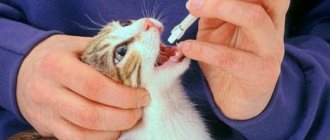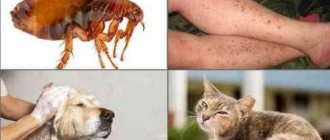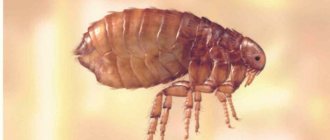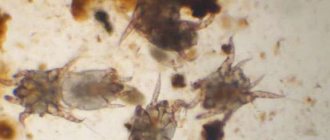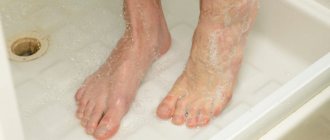Why do cats get fleas?
There are different ways that an animal can become infected with fleas.
- A street walk, and contact with an infected animal is not necessary. Parasites live in grass, sand, and asphalt cracks.
- Contact with a person. Parasites are transmitted from the host. For example, when a person pets a stray cat, fleas can jump onto clothing and then onto the pet.
- Transmission from mother. If a pregnant cat is infected, there is a high chance of transmitting fleas to the newborns. Veterinarians recommend treating the animal’s body with special preparations before the kittens are born.
- Contact with rodents during fishing.
- The presence of fleas at home, for example, if there is a dog that is taken outside.
Where can a cat get fleas?
A cat's fleas can come from anywhere. Sometimes it’s enough just to let him outside for a walk for a while - he will certainly return not only grimy and foul-smelling, but also with a handful of large adult and very hungry fleas.
The most common breeding grounds for these ectoparasites are:
- infected animals;
- mats, cat houses, beds that have already been used by infected animals;
- wild animals (mice, rats, moles, hedgehogs, foxes, badgers, etc.);
- livestock farms, especially fur farms and those where rabbits are bred;
- heavily infested with fleas rooms, basements;
- forest, fields, meadows, forested areas.
Why are fleas dangerous?
Bloodsuckers pose a danger to a cat’s health, namely:
- are carriers of various diseases, including helminths, so the risk of helminthic infestation increases;
- Sores form on the cat's skin due to bites, which can result in hair loss. In addition, the fur becomes dull and has an unkempt appearance;
- insects reproduce quickly, and since fleas feed on blood, the pet’s likelihood of developing anemia increases. If it is a weakened cat or kitten, infection can be fatal;
- an allergic reaction is possible. The presence of fleas increases the risk of developing poorly healing wounds and abscesses where allergens can enter.
The likelihood of infection increases in children, elderly and weakened cats due to low immunity.
In addition to harming the animal, fleas pose a danger to humans. A bite can cause a skin rash, dermatitis, infectious diseases, hematoma, an allergic reaction, even anaphylactic shock. If an insect gets into food, poisoning is possible.
Symptoms of the presence of parasites
There are certain symptoms that indicate the presence of fleas. Signs of infection depend on the extent of the spread of parasites.
Stage
Symptoms
1.
Only an attentive owner can detect the initial stage. At first the animal behaves as usual. Subsequently, the cat begins to scratch itself.
2.
The second stage of infection includes the following symptoms:
- nervousness of the animal;
- the cat bites itself;
- loss of appetite, refusal of favorite foods;
- meow;
- sleep disturbance.
This period is characterized by a large number of fleas (up to 200 pieces). Insects can be seen on the animal's fur. Many bites and wounds appear on the cat's body.
3.
The animal's condition deteriorates noticeably:
- irritability increases;
- the cat doesn't eat anything;
- weight loss;
- the fur falls out in clumps;
- allergic dermatitis develops.
If the owner notices such symptoms in an animal, it is necessary to take action as soon as possible.
Flea removal methods
Help to cope with fleas in felines:
- drugs;
- collars;
- traditional methods;
- other methods.
The best effect is shown by a combination of several control methods at the same time. It is advisable to consult a specialist before use, since in most cases the components are toxic to cats, although they act on insects. After using aggressive means, it is not always possible to save the animal.
Methods for killing flea larvae
Due to the similarity in appearance, it is difficult to immediately determine which flea the larva belongs to. But they can be destroyed using the same methods. Most of the products that are used to kill adult fleas are suitable for combating larvae, and some are completely powerless against nymphs. Thus, the smell of wormwood, which scares away imagoes, will not affect the condition of the larvae. Means that can destroy them include:
- Microencapsulated preparations such as Get, which outperforms competing products due to the absence of odor.
- Concentrates that require dilution according to the instructions. These include Tetrix, Cucaracha, Karbofos. Many of them are toxic and have a pungent odor.
- Aerosols that are convenient and ready for use - Combat with a nozzle for penetrating into the furthest crevices behind baseboards, Raptor. They act, but only locally, as they quickly evaporate, losing their activity.
- Powders Clean House or Pyrethrum are effective in combating flea larvae and are natural. But their use becomes more difficult if the larvae are located under the floor or in other hard-to-reach places.
- Folk remedies, which include kerosene, vinegar and turpentine. A well-known remedy for fleas is pine sawdust. They are often used to fill cat or dog bedding. Their smell repels insects, and they will not be able to lay their eggs here. But if a larva nevertheless emerges from the egg, then such a habitat will not affect it in any way.
Even though the larvae are harmless, it is important to detect and destroy them in a timely manner. After all, in a few weeks they will become adults and dangerous to human health.
You can fight larvae with modern aerosols, solutions, powders, microencapsulated preparations and folk remedies, but the best way is to prevent fleas from entering the room.
Pharmaceutical preparations for fleas
Veterinary pharmacies offer a wide range of drugs to get rid of fleas.
Rolf Club 3D (drops)
The medicine is suitable for cats and kittens over 12 weeks of age. Drops are designed for 1 dose. The contents are applied to dry skin between the shoulder blades. Thanks to this, the animal will not be able to lick the drug. The dosage of the medication depends on the weight of the pet:
- up to 4 kg – 0.5 ml;
- from 4 to 8 kg – 0.8 ml;
- over 8 kg – 0.125 ml/kg.
The drug protects the cat from ticks (for 30 days), fleas (up to 2 months), and flying blood-sucking insects (7 days). Repeated treatment can be carried out no earlier than after a month.
Contraindications:
- tendency to an allergic reaction to the components of the drug;
- infectious animal disease;
- pregnancy;
- feeding period;
- less than 12 weeks old.
Cost – 300-500 rubles.
Bravecto (drops)
Drops are used for cats and kittens older than 11 weeks and weighing more than 1.2 kg. The dose is calculated based on weight:
- from 1.2 to 2.8 kg – 0.4 ml;
- from 2.8 to 6.2 kg – 0.89 ml;
- more than 6.2 kg – 1.79 ml.
1 procedure is sufficient for treatment. For preventive purposes, it is necessary to carry out treatment every 3 months.
Contraindications:
- increased likelihood of allergies;
- the presence of wounds and damage to the skin;
- age up to 11 weeks;
- weight up to 1.2 kg.
The cost is about 1300 rubles.
Frontline (spray)
Frontline is indicated for cats and kittens from 2 days after birth. It is necessary to treat your pet in a well-ventilated area. To prevent the animal from licking the drug, it is better to buy a neck collar in advance. Before use, shake the bottle and, pressing the sprayer, treat the fur from a distance of approximately 15 cm. The amount of product depends on the thickness and length of the coat and is, on average, about 5 ml per kilogram of the pet’s weight. The entire coat needs to be treated.
Contraindications:
- infections;
- high probability of allergies.
Cost – 1600-1900 rubles.
Inspector (drops)
The drug is intended for pets older than 7 weeks. The dosage depends on the cat's weight:
- less than 1 kg – 0.05 ml/0.5 kg;
- from 1 to 4 kg – 0.4 ml;
- from 4 to 8 kg – 0.8 ml;
- over 8 kg – 0.1 ml/kg.
Contraindications:
- presence of an infectious disease;
- weakened cat;
- less than 7 weeks old.
Pregnant and lactating cats should be treated with caution. It is necessary that the animal be under the supervision of a specialist.
Cost – 300-500 rubles.
Beafar (drops)
The medicine is indicated for animals over 2.5 kg and older than 6 months. The dosage depends on the weight of the pet:
- from 2.5 to 5 kg – 0.37 ml;
- more than 5 kg – 0.74 ml.
The volume of 1 pipette of the drug is 0.37 ml.
Contraindications:
- infection;
- pregnancy;
- feeding period;
- weight less than 2.5 kg;
- age less than 6 months.
The cost is about 800 rubles.
Advantage (drops)
This flea treatment is suitable for cats over 10 weeks of age. Dosage according to weight:
- up to 4 kg – Advantage 40 1 pipette;
- from 4 to 8 kg – Advantage 80 1 pipette;
- over 8 kg - at the rate of 0.1 ml/kg.
Contraindications:
- allergy;
- infectious diseases;
- kitten younger than 2 months.
The cost is about 300 rubles.
Fiprist (spray)
Fiprist for cats can be used from 7 days of age. The drug is available in various volumes: 100, 250, 500 ml.
Before use, you need to shake the bottle and, pressing the sprayer, treat the wool at a distance of 10-20 cm. The average dosage is 3-6 ml per 1 kg. The amount of substance that is distributed with one press depends on the volume of the bottle:
- 100 ml – 0.5 ml;
- 250 ml – 1.5 ml;
- 500 ml – 3 ml.
Contraindications:
- infections;
- less than 7 days old;
- intolerance to components.
The cost is about 200 rubles.
Other medications
In addition to the remedies listed above, for quick and guaranteed removal of fleas, you can use drugs in the form of injections, but their use must be agreed upon with a veterinarian. The disadvantages of injections include high toxicity, so the dosage must be strictly observed. Among the most popular are the following:
- Ivermek. It is administered once, but according to indications, the veterinarian may prescribe repeated use. Helps get rid of fleas in a short time. In some cases, your cat may notice increased urination and nervousness;
- Eprimek. It is a liquid with a light yellow color. The solution can be administered subcutaneously or intramuscularly. Do not use the drug if there is an increased risk of an allergic reaction. If the recommended dosage is exceeded, your pet may experience severe agitation and frequent trips to the toilet;
- Lufenurol. It is a colorless liquid. The only drug of its kind that stops the development of flea larvae and prevents further reproduction. But among the advantages there is also a disadvantage - reviews indicate low effectiveness against adult parasites, so it is necessary to use the drug in conjunction with others. If you use Lufenurol with a spray or drops, you can get rid of insects in a short period of time;
- Otodectin. It contains a small amount of hazardous substances, so its use during pregnancy is allowed, but only with the permission of a veterinarian.
In addition to injections, there are tablets for fleas:
- Comfortis. Contains beef, so your pet will happily eat the tablet. You can add it to your usual food. The effect of the tablets lasts for 1 month. The dosage is selected at the rate of 50 mg/kg. It is not recommended to give to pregnant cats, kittens and elderly animals;
- Capstar. It has been on the market for more than 10 years. The drug begins to act 2.5-3 hours after administration. Allowed to give to kittens from 1 month. It is believed that Capstar has no side effects.
How to rid a cat of parasites
Fleas not only cause discomfort to animals and humans, they bite painfully. They carry dozens of deadly diseases and helminth eggs. Fleas can cause weakness and anemia in a kitten. If parasites are found on an animal, flea extermination should be started immediately. In addition to caring for the pet itself, you will need to disinfest the apartment and carefully treat all its belongings, toys, cat house, and accessories.
The choice of means of exterminating and protecting cats from fleas is huge. When choosing a drug for your pet, you should be guided by the age of the animal, ease of use of the product, toxicity and effectiveness of the drug. Arsenal of anti-flea products:
- Antiparasitic shampoos. Conventionally, they are divided into detergents for killing fleas and repelling them. The former contains an insecticide that has a destructive effect on parasites. The product is applied to the cat’s wet skin, left for several minutes, and then washed off. A single treatment is sufficient to kill fleas. Popular detergents are “Bio Groom”, Lugovoi, “Clandestine”, Bars, “Fitoelita”.
- Drops on the withers for cats have a destructive effect and protect the cat from parasites for 2-3 months, depending on the manufacturer. The drops are incredibly easy to use. It is enough to remove the pipette with drops from the packaging and apply the product to the animal’s withers. The death of parasites occurs within 24 hours after application. According to consumer reviews, the following drops have proven themselves well: four with a tail, Frontline, Delix, Rolf Club 3d, Barrier, Dana Ultra Neo, Stronghold, Advantage, Blochnet, Celandine, Helmintal, Inspector.
- Collars for cats to kill insects have the greatest effect if you first bathe the cat with anti-flea shampoo. The following collars are in demand among cat owners: Bars, Celandine, Beafar and others.
- Anti-parasite spray for cats destroys pests and provides long-term protection for your pet from blood-sucking insects. The product is applied to dry skin against hair growth. To prevent the pet from licking the drug, a protective collar is put on it. You cannot bathe your cat 2 days before the procedure and 2 days after.
It is imperative to get rid of fleas. They are dangerous not only for a domestic friend, but also for humans.
Using flea collars
Collars are the simplest means designed to combat fleas. It is allowed to use them both for prevention and for therapeutic purposes. The coating is impregnated with substances that are harmful to insects. Positive properties:
- simplicity;
- ideal for animals that do not like to bathe;
- Possibility of use for pregnant cats and small kittens;
- versatility - the collar protects against fleas and ticks at the same time;
- prolonged action – from 1 to 5 months.
In addition to the advantages, flea collars also have negative qualities:
- the likelihood of injury (for example, if the cat gets its collar caught on something);
- service life is reduced if the collar gets wet;
- effectiveness depends on the individual characteristics of the animal and its state of health.
Before purchasing a collar for your cat, it is best to consult your veterinarian. The most popular brands include: Beafar, Foresto, Kiplix, Bolfo, Bars for fleas.
How to choose an effective remedy
The most effective flea remedy is one that can expel all parasitic insects without harming the health of the cat and its owners. To choose an effective remedy, you need to remember several criteria:
- pet's age;
- characteristics of the cat (allergies, intolerance to some component, fear of spray bottles, etc.);
- physical condition of the animal (illness, pregnancy, breastfeeding kittens, etc.);
- the specifics of the drug (what qualities it should have);
- in what conditions the product should be used (house, apartment, etc.);
- presence of children in the house, etc.
If you know exactly how, where and why the product will be used, then choosing it will not be difficult. The pet pharmacy employee will ask you the same questions. Even if you have already decided on a specific insecticide, you still have to carefully read the instructions and annotation for the drug to make sure that the choice is made correctly. Based on the analysis of various flea remedies, the following conclusions can be drawn:
- To prevent infection, collars and drops on the withers are suitable. These flea control products have a fairly gentle effect on the pet itself, rarely lead to side effects, but at the same time reliably repel fleas.
- If the animal has few fleas, the best remedy for fleas is a collar or drops.
- In case of severe parasite infestation, it is necessary to resort to the use of special flea sprays or shampoos.
- For pets that regularly go outside but live in the city, collars are suitable. You can remove them at home, and the animal’s skin on the neck will not be irritated.
- Animals that are taken to the country for a long period of time need to have drops applied to their necks.
- Kittens and puppies over the age of one month can be bathed with special shampoos. Older kittens can be treated with drops and put flea collars on them.
- It is not recommended to use any insecticides at all on lactating and pregnant cats. Only if the infection is too severe, threatening serious damage to the offspring, can you use special drops or bathe the animal with shampoos.
In order to rid your cat of fleas without harming its health, you need to approach the issue of choosing the best remedy with all responsibility.
Traditional methods of fighting fleas
To get rid of fleas, you can use traditional methods, but it is recommended to use them in conjunction with pharmaceuticals. This is the only way to increase the effectiveness of use. The most popular recipes are presented below.
- To prepare the product you will need salt and a warm infusion of celandine at the rate of 50 g of product per 1 liter of liquid. Mix everything thoroughly. Place the animal in the liquid up to the neck and hold for 5-10 minutes.
- Take 2 cloves of garlic and crush to a paste. Add 700 ml water. Leave it on all night. In the morning, rub the resulting infusion into the cat’s fur, wash it with flea shampoo, and comb it out with a comb.
- Take 20 g of dry and 40 g of fresh wormwood. Pour the mixture with 2 cups of water. Cook over low heat for 10-15 minutes. Cool and apply the resulting mixture to the coat, wash with shampoo, and comb out.
How to remove fleas from a pregnant cat
If a cat is pregnant, you need to select a flea remedy with extreme caution, since the life of the kittens depends on the health of the animal. If you make the wrong choice, there is a risk of miscarriage, congenital abnormalities, or death after birth. Before removing fleas from a pregnant cat, it is recommended to consult a veterinarian to select the most optimal product.
Injectable medications are not recommended for use in pregnant cats as they are toxic. The use of Comfortis tablets is also prohibited. The best option would be to use collars and shampoos. In consultation with a specialist, drops can be applied to the withers.
General characteristics of fleas
In most cases, cat fleas living in a pet's fur belong to one of the most common types of insects - the cat flea or Ctenocephalidesfelis. They can also parasitize other animals, such as dogs, rats, rabbits, and also feed on human blood when the opportunity arises. At the same time, there are other types of fleas on cats. It is almost impossible for a non-specialist to visually distinguish them, but they can be studied in detail in the photos posted in the article.
- after communicating with the inhabitants of the basements;
- taking a walk through a contaminated area;
- by catching insect eggs or larvae with their paws.
People can also bring parasites indoors on shoes or clothes, because flea eggs can fall off the fur of infected animals anywhere.
Externally, parasites resemble small, very smooth and shiny plant grains. Body length reaches 2-3 mm. Different insects of this species differ in the structure of the head and the number of bristles on the legs. They can only be studied in detail using a microscope or by carefully examining the photo of a flea on a cat posted in our article. Parasites have the following structural features:
- The body is elongated and flattened, allowing it to quickly move between the villi of the animal’s fur, and is covered with numerous spines and bristles.
- Lack of wings.
- Long hind legs, providing high jumping ability and the ability to move along the surface at any angle.
- Dark brown or black color of the hard chitinous cover.
- The oral apparatus is piercing-sucking, equipped with a special stylet for piercing the skin.
Flea eggs and larvae
Reproduction of bloodsuckers occurs with a full cycle of transformation, that is, they go through the stages of an adult insect, egg, larvae and pupa. The insect's lifespan is about two years. They reproduce very quickly - a female can lay up to two thousand eggs over the entire period. The flea puts them wherever he needs them. This fact is explained by the fact that it seems to “shoot” them and the contents of the clutch scatter in different directions at high speed. You can see what flea eggs look like in cats in the photographs. Their number can reach up to 30 pieces per day. After about two weeks, larvae emerge from them. In appearance they resemble a worm. Flea larvae in cats live in garbage, dust, or can be found on the bedding of a pet. They feed on decaying organic matter or blood in the excrement of adult parasites. Over time, the larva turns into a pupa and emerges as an adult insect.
Preventing flea infestation
To avoid infection, it is necessary to follow preventive measures:
- Inspect your pet daily to spot fleas as early as possible;
- regularly bathe the animal using flea shampoo;
- wash the bed periodically, adding flea repellent to the water, as insects can accumulate in it;
- do not let your pet go outside (fleas appear on a domestic cat much less frequently, but if it asks to go outside, after each walk it is recommended to carry out bathing procedures using anti-parasitic shampoo);
- put a tick and flea collar on your pet;
- Medications may be used periodically for additional protection.
There are various means to kill fleas - drops, sprays, shampoos, collars - so dealing with the parasite is not too difficult. The most important thing is to use the medications according to the instructions.
How to get rid of eggs and larvae
Flea remedies
Flea eggs look like translucent oval dots about 0.5 mm long. But it is quite difficult to see them, since they quickly dry out after being deposited, become heavy and fall out of the cat's fur. The best place to look for flea eggs is in your cat's bedding and other places where your cat likes to sleep. If the cat is heavily infected, you can look with a magnifying glass at the base of the tail or on the stomach. If there is flea dirt in your cat's bedding, it likely contains flea eggs. Flea dirt is dark and the eggs in it have a whitish appearance.
The larvae hatch from the eggs in two to seven days
It is important to know what flea larvae look like. The flea larva is a translucent worm-like creature with small bristles, about 3 mm long.
Although in photographs the larvae appear reddish when backlit, in life they are usually transparent with a black substance inside.
They try to hide from light sources and get as deep as possible into the cracks and crevices of floorboards and carpets. After this, the larvae, which make up about one-third of the flea population in the house, spend one to two weeks developing and feeding on organic debris and dried flea dirt—the excrement of adult fleas, which is mostly dried blood.
Flea dirt is a rich food source for cat flea larvae. It can be found on the cat or in the litter. It looks like small black dots and can be elongated and curved. The easiest way to tell if it's flea dirt is to shake some of the dirt onto a piece of paper towel or toilet paper and wet it.
The larvae then wrap themselves in cocoons and develop into pupae, which eventually become adult fleas. Flea pupae are harder to see, or rather harder to distinguish. The pupa's cocoon is sticky, which causes dust and dirt to stick to it. The dimensions of the cocoon are about 3 - 4 mm in diameter.
Fleas usually do not cause any major health problems, but some cats may have insect allergies caused by flea saliva. If a cat has a lot of small sores above its tail, then it is very possible that it is allergic to fleas. A cat infested with fleas experiences discomfort and actively itches and bites its fur. Itchy skin can be a sign of an allergy, but biting on the sides usually indicates fleas.
Some cats suffering from parasites scratch themselves excessively, which can cause sores and hair loss. A cat with a lot of fleas may even develop anemia. This is unlikely if the owners are watching the animal. Kittens are more likely to suffer from anemia than mature cats. A lethargic cat with pale gums and nose may be anemic.
There are many means to remove parasites. This:
- Drops.
- Shampoos.
- Aerosols.
- Pills.
- Injections.
The most famous companies producing flea products: Celandine, Biafar, Bars, Frontline, Hartz, Barrier, Advantage, Rolf Club, Mr. Kiss and others. Please be aware that some products may be dangerous and poisonous to humans and cats.
It is important to read labels and use products only as directed. It would be a good idea to consult with a veterinarian, who will prescribe a remedy based on the cat’s lifestyle, age and health condition.
After removing the adult insects from the cat and clearing the eggs, larvae and pupae from the house, it is necessary to prevent a re-infestation. Anti-flea collars are used for prevention
It is important to remember that flea larvae love dark places. Keeping areas such as attics and areas under porches covered will help prevent cats from becoming infested with flea eggs.
